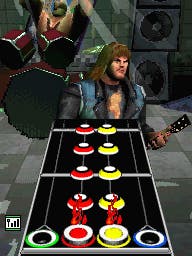Guitar Hero: On Tour
Rock out and about.
Guitar Hero relies on three things to work: a fake guitar to strum and jump around with, a good track selection, and solid and balanced gameplay. Guitar Hero: On Tour for the DS, therefore, shouldn't work. How are you meant to get all that music on a game card? And what about the guitar? It shouldn't work, but oddly it sort of does.
The guitar question is answered by a bespoke peripheral that slots into the GBA slot and gives you four frets to clutch. The prototype we used could attach to the original DS and DS Lite GBA cartridge slots (the depth varies, you may remember) depending on which attachment was screwed in, with a removable plastic cover for changing the logo-clad paper inserts, and a nylon and Velcro strap for fastening it to the player's claw. With the belt tightened, there was no need to grip the DS with the thumb, relaxing our fingers.
The other element of the controller is a plectrum stylus tucked away in a slot. With this in our strumming hand (it's all reversible for lefties), and the DS held in book orientation, we were able to grip fret buttons, as we would in other Guitar Heroes, corresponding to fret icons descending towards us on the top-screen, and strum a guitar graphic on the touch-screen. Scrubbing back and forth didn't seem to work, but a strumming motion that grazed the strings on the screen was an able substitute.
There's quite a lot of music, too, and it even sounds alright coming out of the DS' usually tinny speaker. Since this is considered a travel rather than a performance game, headphones won't be taboo either. Tracks like Blink-182's "All The Small Things" and No Doubt's "Spiderwebs" seem to have been tuned to project the vocal and guitar parts above the clamour of drums and keyboards, but whatever the technical ins and outs the effect is acceptable.

Activision, RedOctane and developer Vicarious Visions are promising over 20 tracks, as you may have read, with six brought in from Guitar Hero III (including Pat Benatar's "Hit Me With Your Best Shot"), and various indie songs to reflect the "touring" element of the Career mode, for a total of over 100 minutes of recorded music.
As for the gameplay, it's almost intact. We held a fret and strummed, holding it down when required to lengthen a note, building a score multiplier up to four by successfully completing chains of notes without error. Star Power is accumulated by completing sequences of notes with star outlines, and can be deployed by saying something suitably rocky into the microphone - or blowing instead, if you're in a public place. The prototype was sensitive enough to activate Star Power in response to the noise of our hitting the screen with the plectrum to strum, but this may be refined. The whammy bar can be waggled with the stylus on elongated notes.
In addition to the Career mode, which features six characters (two new), a DS-exclusive Guitar Duels mode allows you to face off with AI or real-life opponents connected by local Wi-Fi (no Internet play, sadly), and compete, earning and then throwing DS-specific power-ups into play to disrupt one another. The effect of these is that a string may break and you have to reattach it by dragging the stylus pointer from one end of the fret board to the other, or that a fan may jump on-stage and demand you scribble a signature on something (in my case it was a fish), or that your guitar may catch fire, forcing you to huff into the microphone to extinguish it. You can keep three of these power-ups in stock, and one of them allows you to steal your opponents'. Other competitive modes like Face-Off and Pro Face-Off return, too.

The major omission is a fifth fret button. Our PR handler said that Vicarious Visions had experimented with one, but discovered that moving fingers up and down a fret board is too awkward when the device that you're manipulating is bound to your hand. Presumably the impact of this is to concertina the difficulty somewhat, which may discourage hardcore players, but our demo suggested that a decent range of skill will be required across the Career mode.
In other words, Guitar Hero doesn't actually rely on the guitar. But then we already knew that, because we were banging on about FreQuency and Amplitude long before a light-bulb went off in Harmonix's head. What's impressive about On Tour isn't that it succeeds without Guitar Hero's eye-catching prop, but that it might replicate the best elements of that experience without dumbing down too much, and that the other key elements, the music, stands a good chance of ringing out properly.
Look out for our review of Guitar Hero: On Tour closer to its mid-July release.








